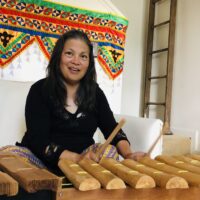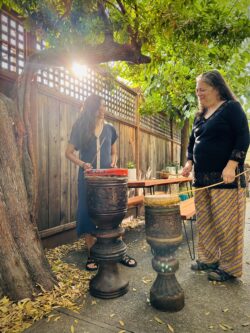Titania Buchholdt (right) and 2023 apprentice Patrici Flores (left) during a lesson in kulintang a kayo. Photo: Courtesy of the artists.

Titania Buchholdt
Kulintang Music of the Philippines
Kulintang is an ancient ensemble musical form usually recognized by the use of the kulintang, a set of suspended knobbed gongs made of bronze, brass, or steel. The ensemble can also include hanging gongs (known as agung and gandingan) and a goblet-shaped drum called a dabakan, which establishes the rhythmic structure of the music. The music is associated with different cultures of the Southern Philippines, including the Maguindanaon, Maranao, Tausug, Sama, Tboli, and Blaan, each of which have a unique kulintang tradition. Traditionally, it is played by community members for their own pleasure, in social competitions, in celebration of special occasions, or to assist in healing ceremonies.
Titania Buchholdt first heard kulintang ensemble music when she danced in a series of Bayanihan-style performances at Alaska Methodist University in 1974. The following year, she traveled to Manila with her mother, where she encountered kulintang ensemble instruments for the first time. Her mother purchased six, which were shipped to their home in Alaska. Afterwards, in early 1976, Buchholdt studied kulintang ensemble music informally with members of the Bayanihan Philippine Dance Company.

In 1993, Buchholdt began taking lessons at Kulintang Arts in the Bay Area, with teachers including Frank Holder, Dana Nunez, and Joey Maliga. She then connected with late master artist Danongan “Danny” Kalanduyan, recipient of the NEA’s National Heritage Fellowship, eventually becoming a central member of his Palabuniyan Kulintang Ensemble.
In 1999–2000, Buchholdt and Kalanduyan were awarded a contract as part of ACTA’s inaugural Apprenticeship Program. Later, Buchholdt studied with other master kulintang musicians in Mindanao, Philippines, establishing herself as an accomplished practitioner of the music and tradition. She entered into the tradition at an early stage of its manifestation within the United States, specifically the California Bay Area. Her understanding of its development, participants, and evolution as a transnational expression between the United States and the Philippines is quite unique. Buchholdt has also co-produced a documentary based on kulintang musicians from five cultures in Mindanao: Maguindanaon, Maranao, Teduray, Tboli, and Blaan.
Apprenticeship Program

2023
Patrici Flores will study kulintang ensemble music and the cultures that gave rise to it, focusing on pieces (modes) from the Maguindanaon and Maranao cultures. She will play the same kulintang pieces on wood and bamboo (a tamlang) instruments, and she will learn the modern interlocking rhythms and melodies played on the other instruments of the traditional Maguindanaon kulintang ensemble.
2017
As a master artist in ACTA’s Apprenticeship Program in 2017, Buchholdt mentored Lauren Benetua on the musical practice of the kulintang ensemble and culture. The apprenticeship centered upon developing Benetua’s skills with the various instruments of the ensemble, focusing on three musical pieces that have culturally significant roles within the Maguindanaon and Maranao cultural groups.
1999–2000
In 2000, Buchholdt was the apprentice to master artist Danongan Kalanduyan, during the inaugural round of ACTA’s Apprenticeship Program.

